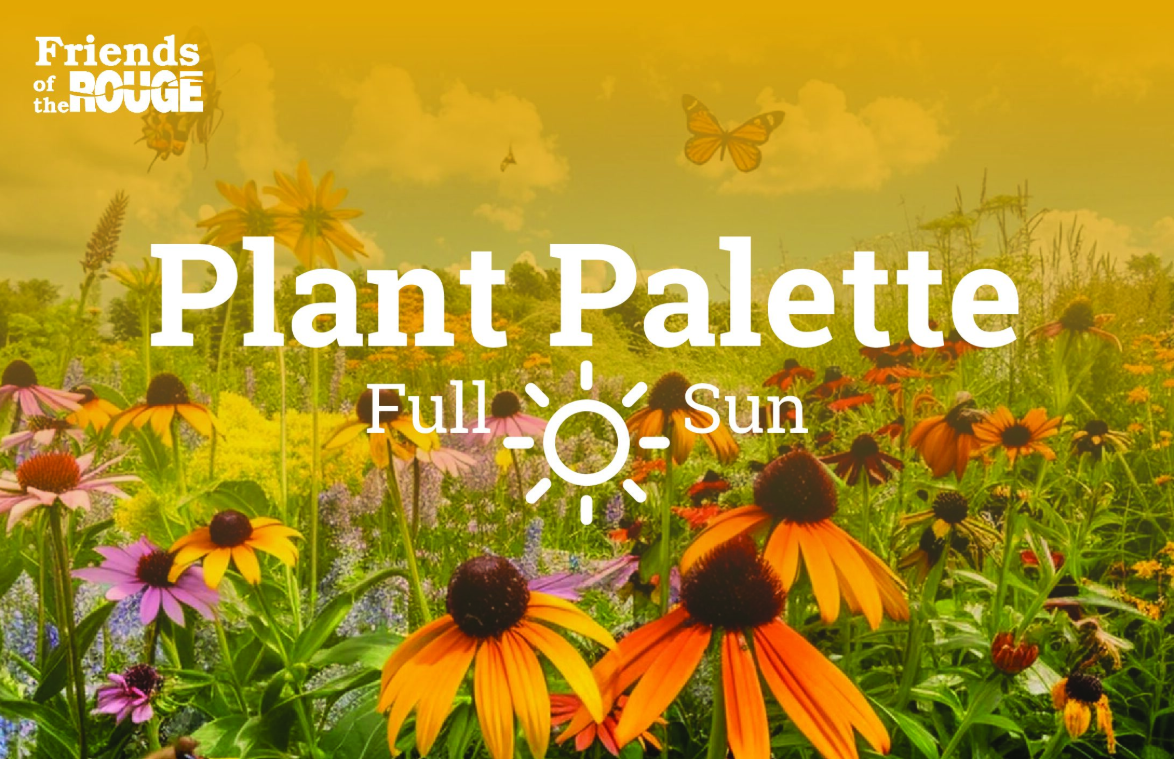What plants should I use?
Friends of the Rouge recommends native species for rain gardens and ornamental landscapes.
- Native plants tend to be the best performers in rain gardens, and have been tested extensively.
- Selecting native plants that can tolerate varying water levels and conditions contributes to a successful rain garden. Native plants have long root structures that help pull water deep into soil and create space in the soil to hold more water under the surface. Having long root structures also helps anchor soils so they don’t get washed away.
- Native bees, butterflies, and birds often depend on native plants for food and shelter. Most caterpillars only eat specific plants, like monarchs depend on milkweeds. Songbirds depend on insects to feed nestlings, and many insects similarly depend on native plants.
See our native plant recommendations below or solicit feedback from nursery professionals about which native plants will work best with your specific site conditions.

Top Rain Garden Plants
See some of the top Michigan native perennial plants used successfully in Southeast Michigan rain gardens.

Shady Rain Garden Plants
Find suggestions for shady rain gardens here.

Sunny Rain Garden Plants
Find suggestions for sunny rain gardens here.

Rain Garden Plants by Sun Category
Developed by Friends of the Rouge, this list includes wildflowers, grasses, trees, and shrubs that are native to Michigan

Rain Garden Plants by Sun Category
Developed by the Washtenaw County Master Rain Gardener Program, this list includes natives and cultivars popular in Michigan rain gardens.
Where can I buy native plants?
Friends of the Rouge provides this list of local native plant providers to help reduce barriers for residents.
- Friends of the Rouge does not recommend any of the businesses listed in this document.
- Friends of the Rouge in no way vouches for the quality of any products.
- Friends of the Rouge is not liable for any negligent acts, errors or omissions by the businesses referenced below.
- We welcome and encourage your feedback on your experiences.
Uncomfortable using native plants? Here’s how to do it.

Messy ecosystem, orderly frame.
You’re probably concerned that native plants look messy. Certainly, some do. The garden to the left features Fox Sedge (Carex vulpinoidea) and Red Maple (Acer rubrum), both native species. The garden works despite the the disheveled sedge for a couple reasons:
- The wild sedge is framed by an orderly design. The linear tree planting and contrasting boulders and stones effectively counterbalance the sedge.
- Use of few species also contributes to a sense of order.
The stronger and cleaner that you frame a native plant garden, the messier the plants can be and still look great to most people.

Framing your Native Plants
The “frame” that your neighbors will find most acceptable is one that looks like other gardens in the neighborhood. People tend to want neighborhood landscapes to look uniform. Look around. What do gardens tend to look like in your community? Below are a few common “frames” that you might keep an eye out for.
- Evergreen hedges, like the boxwood pictured to the right.
- Boulders and rockwork
- Attractive use of mulch.
- Clean and well maintained lawn borders
- Fencing and other landscape hardscapes

Focal points
Careful attention to creating strong focal points strongly affects how people respond to gardens. Most people don’t know or recognize plants. They will pay most attention to the focal plant or object that you’ve arranged.
Structure
A common mistake with rain gardens and native plants is to select plants that look good only in one season. Evergreens, other woody plants, rocks, and walls provide year-round structure to help gardens look good in winter. Bunch grasses similarly often provide great structure in winter time, standing up to snow to maintain form.
